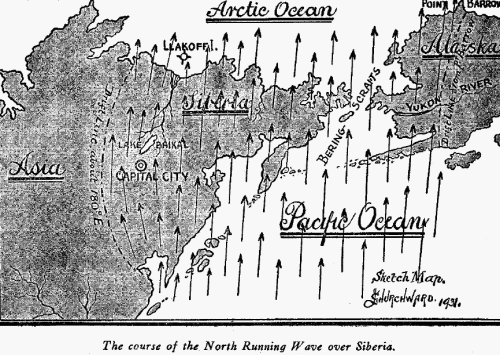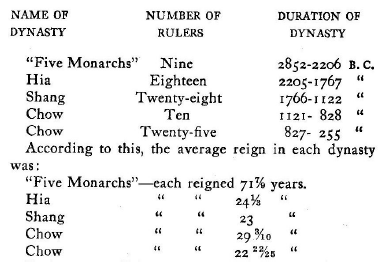|
CHAPTER XIII
Next to Mu herself, the Uighur Empire was the largest empire the world has ever known.
The history of the Uighurs is the history of the Arynn races, for all of the true Aryan races descended from Uighur forefathers.
The Uighurs formed chains of settlements across the central parts of Europe back in Tertiary Times. After the Empire was destroyed by the great magnetic cataclysm and mountain raising, the surviving remnants of humanity or their descendants again formed settlements in Europe.
This was during the Pleistocene Time, The Slavs, Teutons, Celts, Irish, Bretons and Basques are all descended from Uighur stock. The Bretons, Basques, and genuine Irish are the descendants of those who came to Europe in Tertiary Times.
The descendants of
those who survived the magnetic cataclysm and mountain raising.
They had been told that the Uighur capital city lay under the ruins of Khara Khota. They dug through these ruins and then through a stratum of boulders, gravel and sand fifty feet in thickness, and finally came upon the ruins of the capital city. They unearthed many relics but, their money giving out, they had to abandon their enterprise. They met the Russian archaeologist Kosloff and told him of their find.
Subsequently, Kosloff formed an
expedition and continued their work at Khara Khota. Kosloff gave a
report of his findings which I have already given in The Lost
Continent of Mu.
Today are to be distinctly seen in the Gobi Desert the dried-up beds of rivers, canals and lakes in those parts of the Desert where the cataclysmic waters did not wash away all the soil down to bare rocks.
There are several of these washed-off areas
in the Gobi Desert.
I quote from one:
Legendary history states that the Uighurs from the Motherland made their first settlement in Asia, somewhere on the coast of the Yellow Sea of today.
After this records are found of them all through
Central Asia to the Caspian Sea. Then through Central Europe to the
Atlantic Ocean.
I will now consider the following: The cause and date of the
destruction of the Uighur capital city.
This ancient record is absolutely corroborated by
geological phenomena:
Our examinations along the route disclosed the fact that some thousands of years before a huge cataclysmic wave of water without ice had passed over this area, traveling from south to north. We found no traces of this flood beyond the no0 East of Greenwich, but we found the evidences of this wave to the limit of our easterly travels. We did not find a single ice marking in any part of Siberia that we covered, that could in any way be connected with this wave.
Everywhere the proofs were positive that the wave had passed from south to north.
The valley of the Lena appeared to be the main course of the water. Off from the mouth of the Lena is Llakoff's Island.
This island is
composed of the bones and tusks of mammoths and other forest animals
which had been swept up from the Mongolian and Siberian plains by
the flood and carried to this, their final resting place. In these
bones we find a confirmation that no ice accompanied the wave, for
had there been, their bodies and bones would have been mashed into a
pulp, and as in eastern North America, no remains of them would be
found and Llakoff's Island never formed.
The
records tell us that the eastern half of the Uighur Empire,
including the capital city and all of the living things on the land,
were destroyed and wiped out, but that the western and southwestern
parts were left untouched.
How many of the remaining Uighurs, after the flood, survived the destruction caused by the raising of the mountains, cannot be estimated, but very few.
This has always been the case in all areas where mountains have been raised in all parts of the earth. The history of a few remnants of the Uighurs that survived, that escaped with their lives in the mountains as they went up, is told in another chapter. The various mountains running through and around the Gobi changed its watersheds.
The broken condition of the rocks underneath drained the
water from the surface and formed underground rivers. With all water
gone from the surface, the Gobi became what we find it today, a
sandy, rocky, inhospitable waste. Without question water can be
found today within a few feet of the surface in the sandy areas. We
found water from 7 to 10 feet below the surface.
The Book of Manu, an ancient Hindu book, says:
This was probably the migration spoken of by Max Muller as having taken place during the Pleistocene, the second migration of Uighurs into Europe.
It seems to me unquestionable that the early settlers in eastern Europe, as they are called by scientists, were remnants of Uighurs that found their way out from the inhospitable mountains.
This seems verified by Max Muller, who wrote:
He further states that they
came to the Caucasian plains during the Pleistocene, therefore,
after the mountains were raised. As before stated, the Uighurs were
in Europe before the raising of the mountains. Many of the Central
Asiatic tribes today count their time from the raising of the
mountains.
I also give their decipherings.
Tibet lies in Central Asia. It is bounded on the east by
China, on the north by Mongolia, on the south by India, and on the
west by Kashmir and Turkestan. The Gobi Desert is a part of the
northern boundary.
Tibet has been called "the roof of the world."
These appear to have preserved the Original Religion and some of the Cosmic Sciences of the Earth's First Great Civilization I have emphasized the word "some" because these monasteries out of the hundreds in Tibet can be counted on the fingers of one hand. I know of only three.
Most of the monasteries
follow a form of Buddhism.
In the depths of the mountains, on one of the head waters of the Brahmaputra River, are some temples and monasteries. I cannot recollect the exact number now. In one of these monasteries are preserved what is said to be a complete Naacal Library - many thousands of tablets. It was stated to me that this was the Naacal Library which had belonged to the Uighur capital city.
They have a weird, legendary history connected with
these tablets. I mentioned this fact to my old Rishi and asked him
if ever he had heard of them and their weird history. He told me he
had in his younger days visited this monastery and was told the
history of the tablets. I will repeat it as given to rne.
Neither this monastery nor the tablets are unknown; they are well known to Oriental scholars.
To my own personal knowledge, three Englishmen and two Russians have visited this monastery. After recounting this legend, I asked the Rishi whether this library was the only complete one in existence.
His answer was,
It has been suggested to me that in my writings I withhold all names of places, routes, passes, etc., in Tibet. Kashmir and Northern India generally, which might be of value in a political sense. The reason given for withholding this information is a perfectly valid one.
I feel it my duty and pleasure to comply with the suggestion.
The Chinese civilization is referred to and looked upon as one of the very old ones.
As a Chinese civilization it dates back only about 5000 years. It is popularly believed that the Chinese themselves developed their civilization. They did not The Chinese civilization was inherited from their father's side. Again, the Chinaman is looked upon as a Mongol; he is only half Mongol, his forefathers were white Aryans.
During the time of the Uighur Empire, many of the white Uighurs intermarried with yellow Mongols whose country lay to the south of the Uighur Empire, and the descendants of these intermarriages formed the first Chinese Empire.
The record reads:
This without question is a mistranslation, for at the time these marriages were taking place, savagery had never been known on the face of the earth, so that what was meant was unquestionably "the yellow inferior race."
This is borne out by traditions which say that,
Many of the Chinese
today, especially the high class, have quite white skins. This is
the Uighur blood showing in their veins. The regular Chinese coolie,
the lower classes of the Chinese today, have no Uighur blood in
them. They are the descendants of the ancient yellow Mongols.
Another tradition prominent in China is:
I have endeavored to find a collection of the numerous Chinese
legends in the form of a Chinese Legendary History - it may exist but
I have been unable to find it.
Parker says:
From the foregoing one must infer that Parker believes only what he sees and nothing that he hears.
It would appear that it matters not how true a legend may be, it is a myth unless he sees writings which he can believe in. It has been one of my hobbies to trace myths back to see what they come out of. Ninety times out of a hundred I have found that the myth has its origin in a tradition or legend. The tradition or legend has been so garbled that it has become a perfect myth. It should be remembered that there is no smoke without a fire.
I do not doubt for a minute that in many cases what Parker calls
myths are really legends slightly garbled. They are traditions only
to the people, for behind them in the old Tao temples are to be
found written records of the various phenomena.
He shows the rise and fall of the various Mongol tribes and nations. He is, however, absolutely wrong about the Japanese ; and, being wrong about them, other assertions of his are left open to doubt. From his style of writing he would be one to put poor old Marco Polo in prison because he did not bring back a big-horn sheep to show. How Parker accounts for the Gobi ruins and other great prehistoric ruins, I do not know.
Apparently,
such things mean nothing to him.
Confucius, the great Chinese scholar and philosopher, lived from 551 B. C. down to 480, about 300 years after Chinese history commenced to be recorded in China. The Emperor Che Hwang-te, 214 B.C., ordered all books and literature relating to ancient China to be burnt. A vast amount was seized by him and burnt. Some of the works of Confucius and Mencius were included in this conflagration. It was this king who built the great wall of China to keep back the Heung Noo Tartars from constantly raiding northern China.
Che Hwang-te did not succeed in burning all
of the ancient writings, for many were saved and hidden in the Tao
temples where they are now religiously kept and on no account shown
to anyone outside of the priesthood of the temple.
When I say the Uighur Empire of the
Tertiary Era, I mean the Uighur Empire of 20,000 years ago - before
the Magnetic Cataclysm which was the Biblical "Flood," before the
mythical geological "Glacial Period," and before the time when the
mountains were raised.
The last western
outposts were Ireland, Breton in France and Basque in Spain. How far
north in Asia the Empire ran is not known - ancient Uighur cities have
been found far into Siberia.
Mu herself was only
the United States of the world.
|

